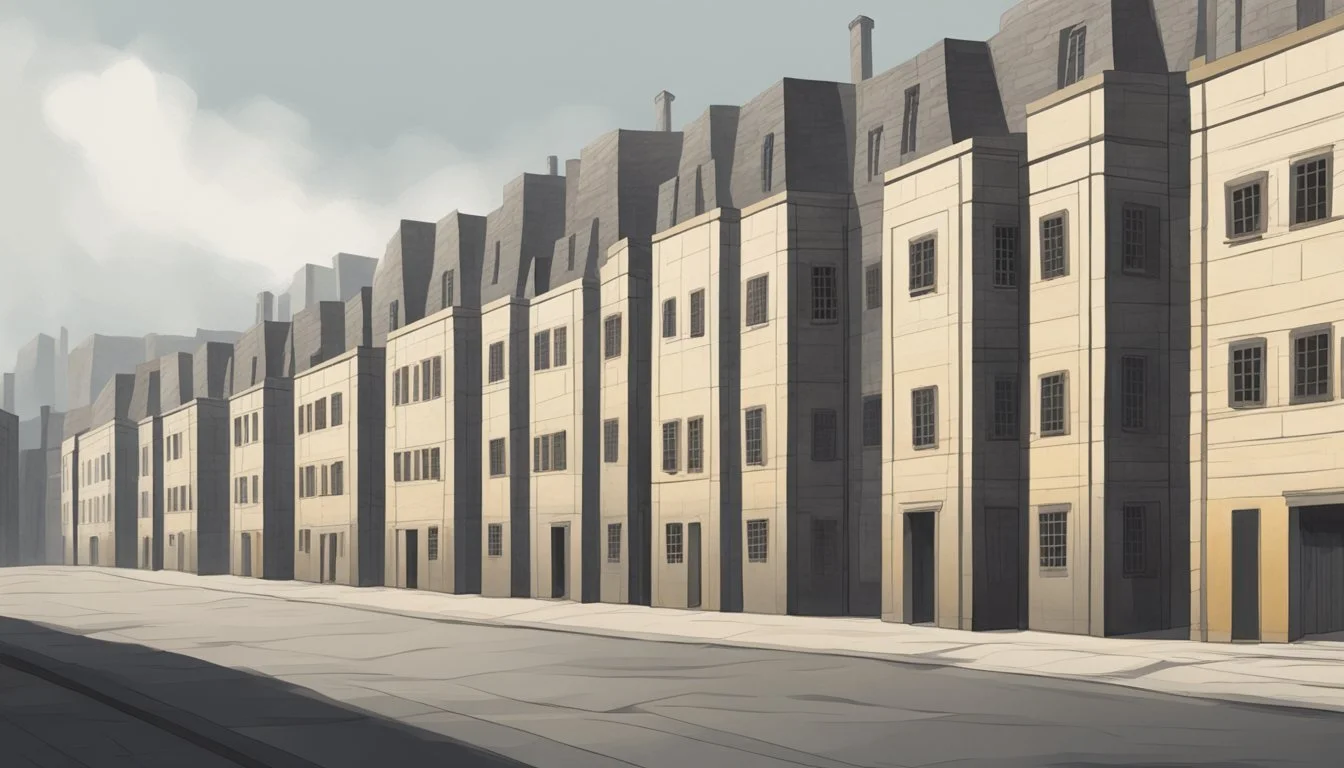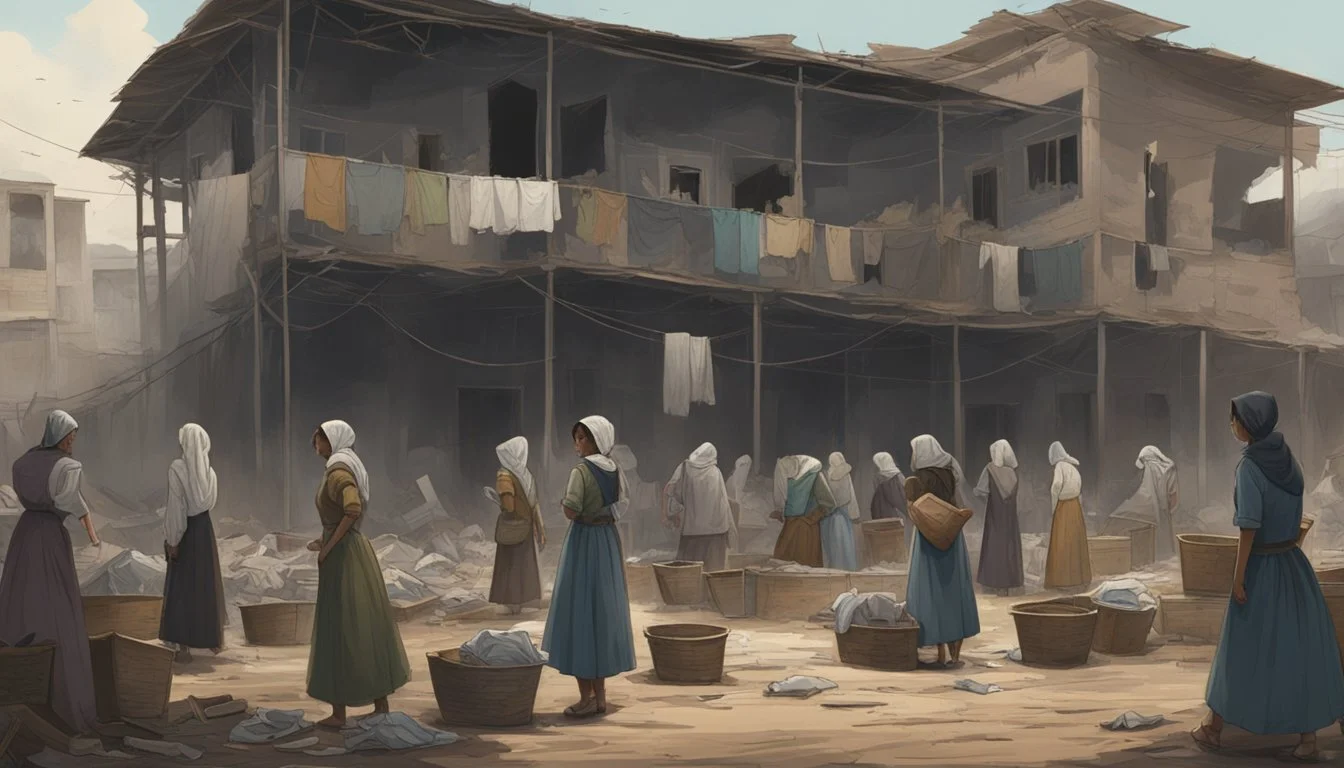Ireland's Magdalene Laundries: The Real Horrors Exposed in Film and History
Ireland's Magdalene Laundries were institutions that operated from the 18th to the late 20th century, ostensibly to house "fallen women." These facilities, primarily run by Roman Catholic orders, became notorious for their harsh treatment of inmates and exploitative labor practices.
An estimated 30,000 women were confined in Magdalene Laundries across Ireland, with about 10,000 admitted after the country gained independence. The institutions forced women to work in laundries under oppressive conditions, often for years without pay. Many of these women were branded as "fallen" due to various circumstances, including unwed motherhood, perceived promiscuity, or even being considered too attractive.
The 2002 film "The Magdalene Sisters" brought international attention to this dark chapter in Irish history. It depicted the harrowing experiences of four young women in a Magdalene Laundry during the 1960s. While the movie raised awareness, the real-life stories of countless women who endured these institutions remained largely untold until recent years. The last Magdalene Laundry in Ireland closed in 1996, leaving behind a legacy of trauma and unanswered questions.
Historical Context of the Magdalene Laundries
The Magdalene Laundries in Ireland emerged as institutions for "fallen women" in the 18th century and persisted well into the 20th century. These facilities, predominantly run by Catholic religious orders, became notorious for their harsh treatment of inmates and exploitation of unpaid labor.
Origins and Expansion in the 18th Century
The first Magdalene Laundry opened in Dublin in 1767. Initially, these institutions aimed to rehabilitate prostitutes and provide refuge for "wayward" women. Religious orders saw them as a means to reform those perceived as morally corrupt.
As Ireland's societal norms evolved, the laundries expanded their scope. They began accepting unwed mothers, victims of abuse, and women deemed promiscuous. The Catholic Church's growing influence in Irish society contributed to the proliferation of these institutions across the country.
Roles and Practices in the 20th Century
By the 20th century, Magdalene Laundries had become a widespread system for controlling women's behavior in Ireland. They operated as a combination of penal institutions and forced labor camps. Women were often sent to the laundries by their families, priests, or state authorities.
Inmates performed grueling work in the laundries without pay. They endured strict regimes, physical punishment, and emotional abuse. Many women spent years or even decades confined in these facilities. The laundries profited from their labor, washing clothes for local businesses and institutions.
The system persisted until the late 20th century, with the last Magdalene Laundry closing in 1996. An estimated 30,000 women passed through these institutions in Ireland between the 18th and 20th centuries.
Life Inside the Laundries
Women and girls in Magdalene Laundries endured harsh conditions, grueling labor, and various forms of abuse. Their lives were strictly controlled by nuns who ran the institutions.
Routine and Conditions
Residents woke early, often around 6 AM, to begin their day with prayer and Mass. Meals were meager and eaten in silence. The laundry work was physically demanding, involving heavy lifting and exposure to harsh chemicals. Women scrubbed, ironed, and folded laundry for up to 12 hours a day, six days a week.
Living quarters were spartan. Dormitories housed multiple women in cramped conditions with little privacy. Personal belongings were confiscated upon entry. Many women had their hair cut short and were given uniforms to wear.
Silence was enforced throughout much of the day. Communication between residents was discouraged or forbidden. Letters were censored, and contact with the outside world was severely limited.
Accounts of Abuse and Labor
Physical punishment was common in many laundries. Women reported being slapped, beaten with sticks, or having their heads shoved into sinks. Psychological abuse included name-calling, humiliation, and threats.
Some survivors described instances of sexual abuse by priests or male workers, though this was not reported in all laundries. Forced adoptions occurred in cases where women gave birth while in the laundries.
The labor was unpaid and often dangerous. Women operated industrial machinery without proper training or safety equipment. Burns, scalds, and injuries from heavy lifting were frequent. The work was repetitive and exhausting.
Confinement was a key aspect of life in the laundries. Many women were unaware of their rights or how long they would be kept. Some remained institutionalized for decades, losing connection with family and the outside world.
The Social and Religious Fabric
Ireland's Magdalene Laundries operated within a complex social and religious context. The Catholic Church's influence, societal views on women's morality, and family dynamics all played crucial roles in perpetuating these institutions.
Ireland's Catholic Church Influence
The Catholic Church held immense power in 20th century Ireland. It controlled education, healthcare, and social services. This dominance allowed the Church to shape moral standards and social norms.
Catholic teachings on sexuality and sin heavily influenced Irish society. The Church promoted strict views on chastity and marriage. It condemned extramarital relationships and unwed motherhood.
Religious orders ran most Magdalene Laundries. These institutions were seen as places of penance for "fallen women." The Church's authority went largely unchallenged, allowing abuses to continue for decades.
Perception of 'Fallen Women'
Irish society labeled women who deviated from strict moral codes as "fallen." This category included:
Unmarried mothers
Victims of sexual abuse
Women perceived as promiscuous
Those considered "flirtatious" or "troublesome"
These women faced severe stigma and ostracism. Many were forced into Magdalene Laundries by families or authorities. Society viewed the laundries as appropriate places for such women to repent and reform.
The concept of "fallen women" reflected deep-rooted misogyny and double standards. Men involved in extramarital relationships rarely faced similar consequences.
Families and Social Stigma
Family reputation was paramount in Irish society. Having a "fallen" daughter brought shame and social consequences. Many families sent women to Magdalene Laundries to avoid scandal.
Some women were committed by:
Parents
Relatives
Local priests
Social workers
The stigma of unwed motherhood was particularly severe. Families often forced pregnant daughters into laundries to hide their "shame." Many babies born in these institutions were given up for adoption.
Social pressure and fear of ostracism led families to prioritize their reputation over their daughters' well-being. This complicity allowed the Magdalene Laundry system to persist for generations.
Government and Legal Involvements
The Irish government, police, and courts played significant roles in the operation of Magdalene Laundries. State institutions collaborated with religious orders to maintain these facilities, while law enforcement and the justice system contributed to the confinement of women.
State and Church Collaborations
The Irish government had extensive involvement with Magdalene Laundries. State departments, including the Department of Defense, utilized laundry services provided by these institutions. Government reports indicate an awareness of the laundries' functions throughout their operation.
The Inter-Departmental Committee's findings, published in 2013, revealed the extent of state involvement. This collaboration between church and state allowed the laundries to persist well into the late 20th century.
Profit was a motivating factor in these partnerships. The laundries provided cheap labor for government contracts, benefiting both religious orders and state institutions financially.
Policing and Court Referrals
Law enforcement and the criminal justice system played crucial roles in maintaining the Magdalene Laundries system. Police routinely returned women and girls who attempted to escape from these institutions.
Courts often referred women to Magdalene Laundries as an alternative to prison sentences. This practice effectively criminalized vulnerable women, many of whom had not committed any legal offenses.
The involvement of police and courts lent an air of legitimacy to the laundries, making it difficult for women to challenge their confinement. This systemic support from legal institutions prolonged the existence of Magdalene Laundries and deepened the trauma experienced by those imprisoned within them.
Scandals and Investigations
The Magdalene Laundries faced intense scrutiny as shocking revelations emerged about abuses and mistreatment. Disturbing discoveries and public pressure led to official investigations and government responses.
Discoveries of Mass Graves
In 2014, historian Catherine Corless uncovered evidence of a mass grave at a former Magdalene Laundry in Tuam, County Galway. Her research indicated that up to 796 children's bodies were buried in a disused septic tank on the grounds. This discovery sparked national outrage and renewed calls for investigations into other Magdalene institutions.
Subsequent excavations at the Tuam site in 2017 confirmed the presence of human remains. DNA analysis revealed ages ranging from 35 weeks to 3 years old. The findings highlighted the high mortality rates and inadequate care at these facilities.
Public Outcry and Official Response
The Tuam revelations intensified public demands for accountability. In 2013, Irish Taoiseach Enda Kenny issued a formal state apology to Magdalene survivors. He acknowledged the state's role in the laundries and the trauma inflicted on the women.
The government established an interdepartmental committee to investigate state involvement with the Magdalene Laundries. Its 2013 report found significant state interaction with the institutions. This led to the creation of a compensation scheme for former residents.
By 2018, over €25 million had been paid to 684 applicants through the scheme. However, some survivor groups criticized the process as inadequate and called for expanded eligibility criteria.
Survivor Experiences and Testimonies
Survivors of Ireland's Magdalene Laundries have shared harrowing accounts of their time in these institutions. Their testimonies reveal the profound trauma and human rights violations they endured.
Personal Narratives
Mary Merritt, incarcerated at High Park laundry, recounts being raped by a priest during her time there. This horrific experience exemplifies the abuse many women faced in these institutions.
Marina Gambold was taken to a laundry at age 16 by a priest. She vividly remembers the humiliation of being forced to eat off the floor, a cruel tactic used to degrade the women.
Maureen Sullivan, sent to a laundry in New Ross at a young age, speaks of the lasting impact on her life. Now 60, she still grapples with the trauma of her experiences.
Aftermath and Trauma
For Kathleen King, childhood in the laundries meant relentless abuse. She was referred to as "Satan," "Red Boy," or simply "No. 5," stripping her of her identity.
Many survivors struggle with long-term psychological effects. The harsh treatment, loss of freedom, and constant degradation left deep scars that persist decades later.
Some women, like those at Sean MacDermott Street laundry, remained institutionalized well into the 1990s. The prolonged confinement compounded their trauma and hindered their reintegration into society.
Closure and Legacy
The closure of Ireland's Magdalene Laundries marked the end of a dark chapter in the country's history. Their legacy continues to shape public discourse and efforts for reconciliation.
Final Laundries and Their Closure
The last Magdalene Laundry in Ireland closed its doors on September 25, 1996. Located on Sean MacDermott Street in Dublin, it was run by the Sisters of Our Lady of Charity. This closure came after decades of declining numbers and increased scrutiny.
In the 1980s, there were still about 60 women living and working in the laundry. The atmosphere remained one of control and harsh conditions until the very end.
The shuttering of this final institution marked a significant turning point in Irish society. It represented the formal end of a system that had operated for over 150 years.
Contemporary Reflections and Media Portrayal
The 2002 film "The Magdalene Sisters" brought international attention to the laundries' history. It sparked public debate and increased awareness of the survivors' experiences.
In the 21st century, there have been ongoing efforts for redress and recognition. The Irish government issued a formal apology to survivors in 2013.
Education about the laundries has become part of Ireland's curriculum. This helps ensure future generations understand this aspect of their history.
Despite progress, challenges remain. Some religious archives stay closed, limiting full investigation. The Church of Ireland has also faced questions about its role in similar institutions.
International Context and Human Rights
The Magdalene Laundries scandal in Ireland was not an isolated incident. Similar institutions existed in other countries, and the issue has drawn attention from international human rights bodies.
Global Perspective on Institutional Abuse
Institutional abuse of vulnerable individuals occurred in various forms across the globe. In Europe, Australia, and North America, similar establishments to Ireland's Magdalene Laundries operated under different names. These institutions often targeted unmarried mothers, orphans, and other marginalized groups.
In Australia, the "Forgotten Australians" endured comparable experiences in church-run homes and orphanages. European countries like France and Spain had their own versions of these institutions. The widespread nature of such abuses prompted international scrutiny and calls for accountability.
United Nations' Stance on the Issue
The United Nations has taken a firm stance against the human rights violations associated with the Magdalene Laundries. In 2011, the UN Committee Against Torture criticized Ireland's failure to protect the women and girls in these institutions.
The UN Human Rights Council urged Ireland to conduct thorough investigations and provide redress to survivors. This international pressure played a crucial role in pushing the Irish government to acknowledge its responsibility and take action.
The UN's involvement highlighted the global importance of addressing historical abuses and ensuring justice for victims of institutional mistreatment.
Steps Toward Healing and Restoration
Ireland has taken significant measures to address the injustices of the Magdalene Laundries. These efforts aim to provide recognition, support, and compensation for survivors while promoting public awareness.
Public Apologies and Redress
In 2013, the Irish government issued a formal apology to Magdalene Laundry survivors. This acknowledgment marked a crucial step towards healing. The state established a compensation scheme to provide financial redress to those affected.
The scheme offers ex gratia payments based on the duration of stay in the laundries. Survivors receive lump sums and enhanced pension benefits. Additionally, the government provides health and social care supports to address ongoing needs.
The Catholic Church, which ran many of the laundries, has also offered apologies. Some religious orders have contributed to the redress fund, though critics argue their contributions are insufficient.
Ongoing Support and Education
Support services for survivors continue to evolve. The government funds counseling and outreach programs specifically tailored to Magdalene women. These services help address trauma and assist with reintegration into society.
Educational initiatives play a crucial role in healing. Schools now include the history of Magdalene Laundries in curricula. Museums and memorials have been established to preserve survivors' stories and educate the public.
Universities and researchers actively document and analyze this chapter of Irish history. Their work ensures that the experiences of Magdalene women are not forgotten and informs ongoing policy discussions.





